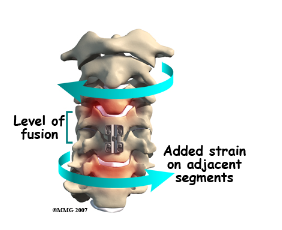Adjacent Segment Degeneration (ASD) is a long-term complication of spine surgery that can be seen on an x-ray, CT scan, or MRI. It occurs after a spinal fusion surgery is complete and affects the segments above and below the surgery site. This condition results from increased load stress on levels of the spine that are near to areas addressed by fusion surgery. As a result of this extra load, the affected areas have a tendency to degenerate at an accelerated rate.
What Causes the Joints to Degenerate?
During fusion surgery, you lose the ability to move your spine at the place where the procedure was done as vertebrae are fused together. This means that bending, arching, twisting, and tilting your spine will be compromised, but you don’t lose those motions. After fusion surgery, these motions are enabled from the joints next to the surgery site which accommodate the things you do many times each day.

Sitting, standing, walking, reaching, lifting, and other activities are still possible, but to perform these actions there is reliance on the adjacent segments of the spine. And with these adjacent segments taking on an additional workload, they have double duty to perform and make up for the immovable portion of your spine leading to degeneration.
Is Adjacent Segment Degeneration Painful?
When adjacent segment degeneration is found on an x-ray, CT scan, or MRI, it is often discovered without any symptoms. Pain is not present and the patient is not aware that degeneration is taking place. But, if symptoms emerge, adjacent segment degeneration may be diagnosed by a doctor as adjacent segment disease. This is merely a progressed form of ASD in which symptoms are now present.
Minimally Invasive Treatments to the Rescue
Your spine is built for movement, but at the same time, it also has to be stable. This duality can be confusing and lead to fusion surgery. But when a back fusion procedure locks the vertebrae into place and makes the spine immovable, a portion of our body that is supposed to give us flexibility is now locked into place. Any patient that undergoes this type of procedure has to accept the risk that later in life, more spinal surgery may be necessary.
However, minimally invasive and endoscopic procedures spare the supporting structures of the spine (i.e. adjoining muscles and ligaments) and reduce the chance of “collateral damage” that leads to ASD. It is safe and effective for many conditions, but may not be the best option for complex situations. The solution to ASD is NOT another fusion surgery. More fusions will create more problems and consequently more ASD. Contact the Minnesota Spine Institute today to see if you are a qualified patient as ASD can be treated without fusion surgery. Although the original fusion cannot be reversed, different treatment options can be explored. Submit your MRI today, and let’s talk!
Related Article: Do I Suffer from Failed Back Surgery Syndrome (FBSS)?
